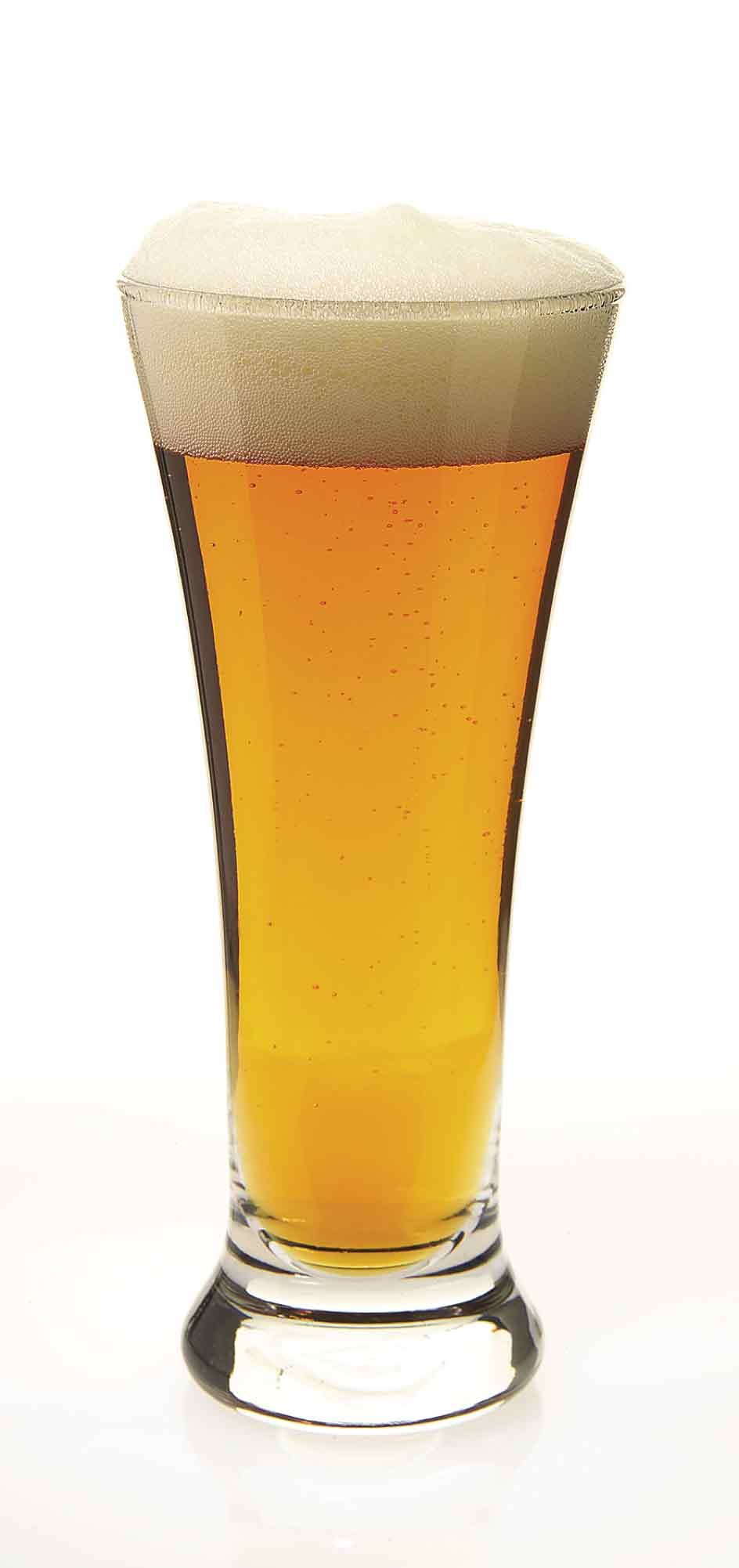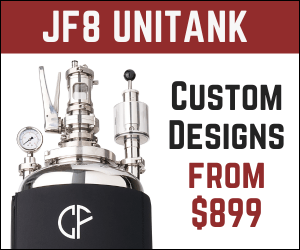10 Keys to Great Lager

There are many good reasons for this. Lager beer styles are usually differentiated from their ale counterparts by the use of bottom-fermenting yeast strains. These strains work best at lower temperatures than are necessary for most ale fermentations. Lager beers also typically incorporate long-term secondary conditioning. This often lasts weeks or even months longer than a typical ale fermentation.
The result is that lager beers usually have a much cleaner, crisper aroma and flavor profile than can be produced by top-fermenting ale yeast at warmer temperatures. But the relative ease of using a top-fermenting yeast strain, the shorter fermentation and maturation times, and the higher level of esters (fruity flavors) typically encountered in ales make them appealing to brewers. Ales typically have a greater margin for error that can help to cover up minor deviations or inconsistencies in the flavor profile. All of these factors work in favor of the ale fermentation when brewing at home.
Does this mean that you should not or cannot produce high-quality authentic lager styles at home? Not at all! By keeping in mind some of the traits that separate lagers from ales, homebrewers can produce lagers that are every bit as good if not better than their commercially produced cousins. The tips that follow are aimed at helping you to maximize your chances for reproducing that crisp, clean lager flavor and aroma found in good commercial lagers produced around the world today.
1. Remember, patience is a virtue.
Lager is a derivation of a German word, lagern, originally meaning “to store.” The original lager styles were the result of long-term storage in caves far beneath the ground. While a typical ale can be brewed, bottled, and begin being consumed as quickly as two to three weeks, lager takes weeks or even months longer to develop. It is a law of nature that as temperatures drop, the metabolism of most organisms begins to slow down. Yeast cells are no exception.
While a lager fermentation goes through pretty much the same phases as an ale fermentation, it does so considerably slower because of the temperatures involved. True success in lager brewing can only be achieved by waiting while each phase in the fermentation and conditioning process is allowed to run its course at its own pace. By abbreviating any part of lager production, you increase the possibility of creating uncharacteristic off-flavors that will stand out as flaws in the finished beer.
When in doubt it is usually a good idea to wait a few days longer before racking or bottling a lager beer. Also, it is not uncommon for lager fermentations to exhibit some rather unusual aromas such as burnt matches or other sulfur characters during the fermentation. With patience and time these characteristics usually fade and disappear, leaving a clean finished beer.
2. Control temperature well.
All yeast strains have a temperature range under which they give optimal fermentation results. With most lager strains this temperature range can be anywhere from as low as 38° F to as high as 60° F, depending on the actual yeast strain. It is very important, once the optimal performance range for a particular type of yeast is determined, to keep the fermentation within these boundaries. Store the fermenter with a thermometer inside or use a stick-on type thermometer. This makes monitoring fermentation temperatures a simple task.
Usually, the most accurate solution to temperature control involves converting a refrigerator or freezer into a controlled storage cabinet for fermenters. The optimal fermentation range of most yeast strains, even lagers designed for cold fermentations, is outside of the normal temperature range of these appliances. So some sort of modified temperature control needs to be attached to allow the unit to run properly and accurately at temperatures higher than it was originally designed to. But these types of controls are readily available with complete instructions for their use. For brewers who are unwilling or unable to invest in a spare refrigerator dedicated only to brewing, proper temperature control is still easily obtainable. Remember that lager brewing predates modern refrigeration technology, and by employing methods practiced by lager brewers in the early days, it is a simple matter to achieve a relatively consistent, low-temperature fermentation with just a little effort.
Keep fermenters in colder areas of the house, such as the basement or garage. If you live in a particularly hot area, you might need to limit lager brewing to the colder winter months. But remember that air changes temperature much more rapidly than liquid. Protect your fermenter from direct sunlight (you should always do this, whether you’re worried about temperature or not), and insulate it with some form of cover. While the daytime and nighttime air temperatures might fluctuate by as much as 20 or 30 degrees, over the same period the temperature in your fermenter will only fluctuate a few degrees. This kind of fluctuation is well within the acceptable range for most commercially available lager yeast strains.
For brewers wanting to make lagers in warmer climates without the benefit of a spare refrigerator, low fermentation temperatures can be maintained by placing the fermenter in some type of water bath such as a large bucket or small plastic trash can. Some brewers even go as far as to maintain a supply of several one- or two-liter plastic soda bottles filled with water and placed in the household freezer. The thawed bottles are removed from the water bath and swapped with frozen ones from the freezer at regular intervals, such as once or twice a day. A relatively stable temperature can be maintained by varying the number of frozen bottles added to the water bath and how often they are replaced. While this is a labor-intensive procedure, it has been used successfully to maintain fermentation temperatures consistently in the 45° to 50° F range even in balmy Southern California.
3. Use a true lager-type yeast.
Today there are more quality yeast strains available to homebrewers than at any other time. For brewing an authentic lager at true lager temperatures, the very best option is to choose a liquid yeast strain or culture. While these yeast strains cost a little more than dry yeast strains, they usually give far better and more consistent results. This is especially true at the lower temperatures associated with brewing lager.
These liquid cultures usually are superior in terms of purity and performance, and they are available in different strains to produce a wide variety of specific lager styles. In addition most yeast suppliers can provide information regarding optimal fermentation conditions for a particular yeast strain. Even brewers located in more remote areas usually can obtain high-quality liquid yeast cultures through mail order.
4. Use a yeast starter.
While this is good advice for any homebrewer using liquid yeast, it is particularly important to make a yeast starter when brewing a true lager. Remember that the metabolism of yeast, even lager yeast, slows greatly as the temperature begins to drop.
During the critical growth phase following pitching, the yeast cells are reproducing to give enough cells for fermentation. The reduced temperatures involved in lager brewing delay the onset of growth. This can result in a lag phase that is unacceptably long, allowing bacteria to reproduce and leaving the potential for contamination.
A good way to avoid this problem is to pitch a greater amount of yeast, usually two to three times greater cell volume than necessary for an ale fermentation. The best way to achieve this is by pitching a healthy slurry of yeast harvested from a previous lager batch or by creating a yeast starter a few days prior to the actual brew.
5. Use Irish moss and a vigorous full-wort boil.
Proteins are the prime component in chill haze. In addition extended contact time in the fermenter between the beer and the protein trub (the sediment that collects at the bottom of the fermenter) can result in the creation of off-flavors.
This is particularly important for lagers because they ferment considerably longer than ales, and the cold fermentation temperatures lagers use cause proteins to settle out. Maintaining a hard, rolling boil, boiling all of the wort (rather than topping off in the fermenter), and adding a fining agent such as Irish moss causes proteins to precipitate (fall out of solution). Thus, a lot of these proteins can be prevented from making it into the fermenter where they can cause harm. This also creates a brighter, cleaner final product.
6. Use a wort chiller.
Failure to quickly and rapidly drop the temperature of the wort as close to fermentation temperature as possible can result in a strong, healthy, and premature initial fermentation. In this case the bulk of the fermentation takes place long before the wort cools to the optimal fermentation range, creating a lager that exhibits ale-like esters and characters. Furthermore, rapid wort chilling accelerates the coagulation of proteins and helps prevent some of the difficulties involving proteins in the fermenter.
Most homebrewers do not have the ability to quickly and easily chill boiling wort to true lager fermentation temperatures. But getting the temperature to 60° F or lower puts the breaks on premature fermentation. This should allow you to drop the temperature the rest of the way during the lag phase before full primary fermentation kicks in.
7. Use a two-stage method of fermentation.
Even with a hard boil and the use of fining agents, protein trub will still make it into the fermenter. Racking a beer from a primary fermenter into a secondary fermenter or lagering vessel eliminates this additional protein. It also removes the yeast sediment, which can result in yeasty characters and off-flavors if it is left in contact with the beer.
With a healthy fermentation, an adequate volume of yeast for conditioning remains in suspension within the beer even after the sediment is removed. Most lagers really develop their clean, finished character through an extended conditioning period of several weeks at temperatures on the low end of the yeast strain’s performance range. Racking into a secondary fermenter allows this process to take place without creating any off-flavors or aromas.
8. Incorporate a diacetyl rest into the fermentation.
A natural byproduct of yeast fermentation is a compound called diacetyl. It can result in a buttery or butterscotch-candy flavor in the finished beer. While these characteristics are normal and even desirable in some ale styles, in most lagers any trace of diacetyl is a substantial flaw that detracts from the clean character of the beer.
Toward the end of fermentation and before the yeast begins to settle out, the yeast metabolizes and reduces the diacetyl. The colder temperatures of lager fermentation not only slow this metabolic reaction, but they increase the tendency of the yeast to settle out, or sediment, more quickly. This decreases the time available to reduce these compounds.
To offset this, many brewers incorporate a diacetyl rest after the bulk of the primary fermentation is complete, a time that is easily determined with hydrometer readings. The fermenter is slowly warmed to 50° to 55° F for two to five days. Then the temperature is dropped down to conditioning temperatures. Not only does this brief rise in temperature speed up the reduction of diacetyl-causing compounds, it also ensures that the primary fermentation is indeed complete.
9. Select appropriate ingredients for the style of lager you are brewing.
One of the great joys in homebrewing is the versatility of being unrestricted by style and commercial considerations. But keep in mind that the predominant characteristic in most true lager styles is a crisp, clean aroma and flavor. Hops and malt work together without being overshadowed by yeast characters and aromas.
Proper selection of ingredients is critical to this balance. A malt or hop variety that is perfectly acceptable in a fruity, estery ale might be entirely out of place in a lager, resulting in sulfury, grassy, or smoky overtones that could overshadow the cleanliness and balance of a well-made lager. By all means do feel free to experiment with ingredients, but if your goal is a clean, traditional lager, keep in mind the ingredients that were originally used to produce the style in question.
10. Sanitize!
While proper and effective sanitation is critical in all brewing styles, its importance in lager brewing can be more dramatic for two reasons.
Most lager beers undergo a long aging period. While this usually takes place at lower temperatures, bacteria can still grow and thrive —just more slowly. The long aging period gives the bacteria an extended period to develop to levels above the flavor threshold, the point at which the off-flavor can be perceived in the beer. So one level of sanitation might be perfectly acceptable for producing an ale that is to be fermented and consumed within six weeks. But this same level of sanitation might be inadequate for a lager, which most likely will be much older when it is consumed.
In addition the estery character that is an important part of many ale fermentations can mask minor contamination. But in a clean lager the same minor contamination is much more apparent. Brewing a quality lager beer style does require slightly more effort and additional techniques that are not necessary when producing an ale. Many of the tips described here are good ideas regardless of whether you’re brewing an ale or lager. But incorporating them into your brewing regimen will allow the lagers you produce at home to have all of the distinctive characteristics of their commercial counterparts.



